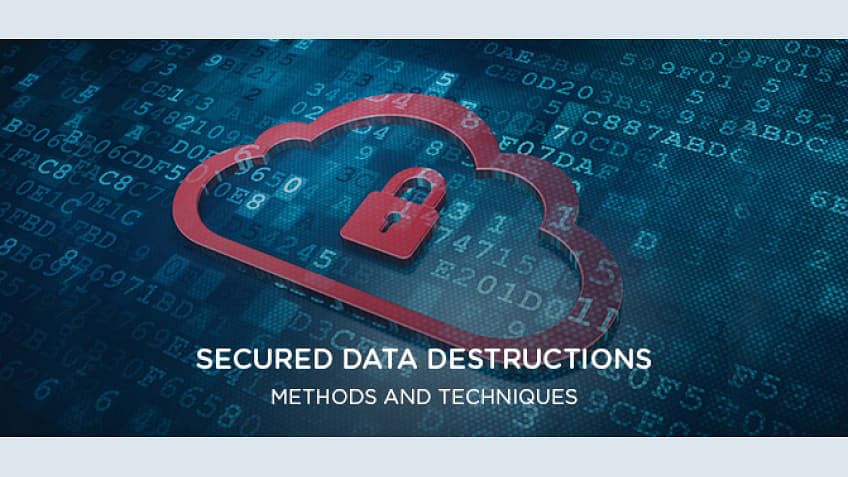Crucial Cyber Security Practices for Effective Data Destruction Methods
Crucial Cyber Security Practices for Effective Data Destruction Methods
Blog Article
Exploring the Importance of Information Damage in the Context of Computer Protection Services and Protecting Confidential Data
In an era where information breaches are significantly usual, the value of effective data damage can not be overstated. What techniques can companies carry out to enhance their information devastation protocols?
Recognizing Information Destruction
Information devastation is a crucial part of computer system protection that involves the long-term removal of information from storage devices to avoid unauthorized gain access to and possible information breaches. In a significantly electronic landscape, companies deal with enhanced dangers linked with delicate details being improperly accessed or made use of. Reliable data devastation safeguards against these hazards, making sure that personal dataâEUR" such as client details, copyright, and economic recordsâEUR" can not be recouped after disposal.
Recognizing the relevance of information devastation expands past simple compliance with regulative and lawful structures; it is crucial for preserving organizational integrity and count on. When data is poorly managed or improperly ruined, the effects can be extreme, including monetary loss, reputational damage, and legal responsibilities.

Methods of Information Elimination

One prevalent method is data wiping, which involves overwriting existing data with arbitrary patterns multiple times. This strategy renders the initial information irretrievable, making it a popular selection for companies looking for to shield secret information.
One more approach is degaussing, which makes use of a powerful magnetic field to interfere with the magnetic domains on storage devices, effectively erasing the information. This method is especially efficient for magnetic media yet is not suitable to solid-state drives.
Physical destruction is another durable approach, squashing or involving the shredding of storage tools. This technique warranties that data healing is basically impossible, making it ideal for very sensitive information.
Finally, encryption can work as a corresponding approach to data elimination. By securing data prior to removal, companies can add an extra layer of safety and security, making certain that even if remnants are recouped, they stay hard to reach without the decryption key. Each method should be chosen based on the degree of data sensitivity and the particular safety and security demands of the organization.
Legal Conformity and Information Safety
Organizations have to navigate an intricate landscape of legal demands associated with data security, particularly after carrying out methods of data elimination. Numerous guidelines, such as the General Information Protection Law (GDPR) and the Medical Insurance Mobility and Liability Act (HIPAA), impose rigorous guidelines on exactly how companies have to deal with and dispose of delicate data. Failing to abide by these regulations can bring about considerable legal effects, including significant fines and reputational damage.
Data devastation processes have to be carefully documented to show compliance with applicable laws and standards. This documents not just functions as proof of adherence to legal obligations yet also illustrates a dedication to securing sensitive details. Organizations must additionally develop clear policies relating to data retention and destruction timelines, guaranteeing that information is not held longer than necessary.

Furthermore, routine audits and assessments of information damage methods are crucial to maintain compliance and adapt to developing lawful structures (data destruction). By proactively resolving legal needs, companies can minimize dangers connected with data violations and demonstrate their dedication to information protection. Inevitably, focusing on legal conformity in data destruction procedures is not just a governing responsibility, however a basic aspect of a durable data safety and security approach
Influence On Business Reputation
The credibility of a business can be significantly affected by its technique to data destruction and management. In today's digital landscape, where data breaches can occur at any kind of moment, the failing to appropriately throw away delicate information can result in extreme repercussions. Organizations that inadequately manage information damage threat exposing confidential consumer information, which not just breaches personal privacy regulations but likewise deteriorates count on among stakeholders and clients.
A ruined credibility can lead to decreased customer loyalty, as clients come to be read review hesitant to involve with a business that has demonstrated carelessness in securing their information. Unfavorable promotion bordering a data breach can have a long lasting impact, as potential clients might be hindered by the perceived lack of security. This can result in a direct decline in profits and market share.
In addition, services that focus on information devastation as component of their security approach can boost their online reputation by showcasing their commitment to safeguarding delicate information. By taking on rigorous data monitoring methods, companies can not just mitigate threats but likewise place themselves as reliable entities in their corresponding industries, consequently enhancing their total brand picture.

Finest Practices for Secure Disposal
Carrying out ideal methods for protected disposal of information is necessary for mitigating risks linked with data violations and ensuring conformity with privacy policies. Organizations should embrace an extensive data disposal policy that details treatments for both digital and physical data destruction.
For physical information storage devices, such as disk drives, shredding or degaussing is advised to avoid information healing. Furthermore, companies must maintain a chain of wardship paperwork during the disposal procedure, making certain liability and traceability of disposed things.
For digital information, utilizing software that abides by sector criteria for information wiping is vital. This software must overwrite existing data multiple times, making recuperation practically impossible. It is also vital to verify the performance of the data destruction procedure via audits or third-party evaluations.
Educating workers on protected disposal techniques adds one more layer of security, as human mistake can frequently lead to data exposure. Routinely upgrading and evaluating disposal policies makes sure placement with advancing laws and technological advancements. By implementing these ideal techniques, organizations can considerably decrease the threat of unauthorized information gain access to and enhance their general information protection approach.
Final Thought
In conclusion, data devastation is a basic facet of computer protection solutions that makes certain the protection of secret information from unapproved access. Implementing efficient approaches of information obliteration, adhering to legal compliance, and recognizing the effect on company credibility are crucial elements of a detailed data security method. By adopting finest methods for safe disposal, organizations can promote trust fund with clients and protect delicate data, eventually adding to an extra secure digital landscape.
In a period where information violations are progressively common, the value of effective information damage can not resource be overstated.Information damage is a vital element of computer system safety that involves the irreversible elimination of information from storage gadgets to avoid unapproved access and prospective information violations. Organizations ought to also develop clear plans relating to information retention and devastation timelines, ensuring that information is not held longer than essential.
By proactively attending to lawful needs, organizations can alleviate threats see this here associated with data breaches and demonstrate their commitment to data protection (data destruction). Inevitably, prioritizing lawful compliance in information damage procedures is not simply a regulative responsibility, but a fundamental facet of a durable data safety method
Report this page